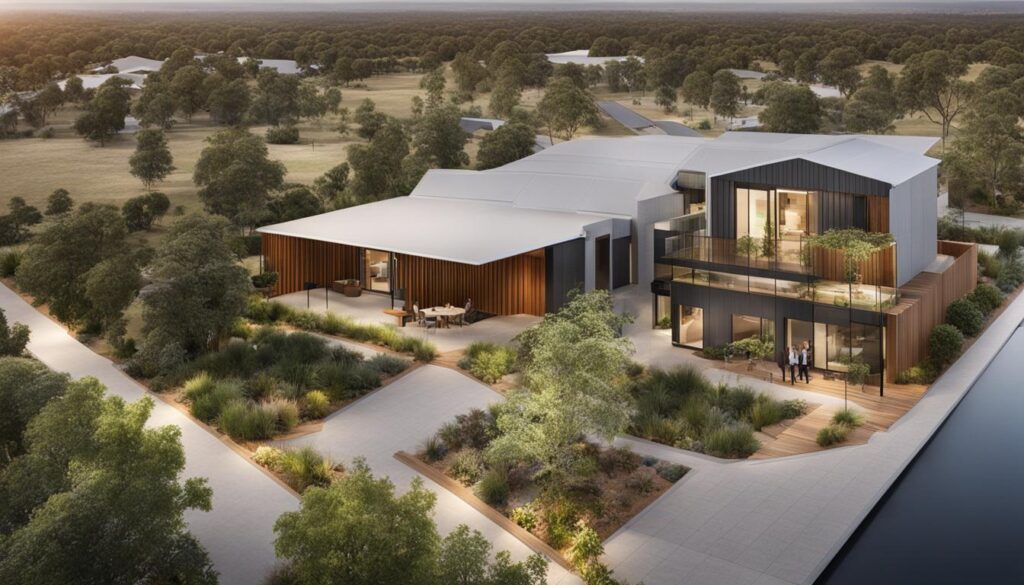G’day mates! Today, I’m excited to dive into the fascinating world of Environmentally Sustainable Design (ESD) in the Greater Bendigo City Council. As we journey through this article, we’ll uncover the initiatives, policies, and tools that are shaping a greener future for this vibrant Australian community. So, grab your eco-friendly cuppa and join me on this sustainable adventure!
Key Takeaways:
- The City of Greater Bendigo Planning Scheme requires developments to submit a Sustainable Design Assessment to promote ESD.
- The Built Environment Sustainability Scorecard (BESS) evaluates the sustainability of medium to large-scale buildings.
- The National Construction Code of Australia sets energy efficiency standards for buildings.
- The Green Building Council Australia provides Green Star ratings for large-scale buildings.
- Greater Bendigo is working on a Sustainable Subdivision Framework to assess the environmental performance of subdivisions.
Now that we’ve got a glimpse of what’s to come, let’s delve deeper into each section and discover how the Greater Bendigo City Council is shaping a sustainable future for its residents and the environment.
Environmentally Sustainable Design Policy in Greater Bendigo
When it comes to promoting sustainable building practices, the Greater Bendigo City Council is leading the way with its Environmentally Sustainable Design (ESD) Policy. This policy, integrated into the Council’s Planning Scheme, mandates the submission of a Sustainable Design Assessment for certain residential and non-residential developments. By incorporating ESD principles into the planning permit process, the Council aims to reduce the environmental impact of new constructions and encourage sustainable design practices.
One of the key benefits of the Environmentally Sustainable Design Policy is that it streamlines the planning permit process. By requiring developers to submit a Sustainable Design Assessment, the Council can identify opportunities for sustainable improvements right from the start. This not only helps to expedite the approval process but also ensures that new developments are designed with energy efficiency and environmental considerations in mind.
In addition to streamlining the permit process, the ESD Policy also helps to lower long-term running costs for building owners and occupants. By encouraging the use of sustainable building materials and incorporating energy-efficient features, developers can create structures that are not only environmentally friendly but also cost-effective to operate. This aligns with the Council’s commitment to creating a greener and more sustainable future for the Greater Bendigo region.
The Environmentally Sustainable Design Policy in Numbers
| Policy Provision | Requirement |
|---|---|
| Sustainable Design Assessment | Mandatory for certain residential and non-residential developments |
| Environmental Impact Reduction | Goal to minimize the environmental impact of new constructions |
| Streamlined Permit Process | Efficient evaluation and approval of sustainable design practices |
| Lower Running Costs | Sustainable features leading to cost-effective building operation |
With the Environmentally Sustainable Design Policy, the Greater Bendigo City Council is taking a proactive approach to ensure that new developments are in harmony with the environment. By promoting sustainable building practices, the Council is creating a greener and more sustainable future for the region, one construction project at a time.
The table above summarizes the key provisions and requirements of the Environmentally Sustainable Design Policy in Greater Bendigo. It highlights the mandatory nature of the Sustainable Design Assessment for certain developments and emphasizes the goals of reducing environmental impact and lowering running costs. By implementing such policies, the Council demonstrates its commitment to sustainable urban planning and the overall well-being of the community.
Built Environment Sustainability Scorecard
I recently had the opportunity to discover the incredible benefits of the Built Environment Sustainability Scorecard (BESS), an online assessment tool that revolutionizes the sustainable design assessment process. Designed for the Sustainable Design Assessment in the Planning Process (SDAPP) framework, BESS sets best practice benchmarks across various environmental categories. It can be used to evaluate the sustainability of any building, from small-scale residential projects to large mixed-use developments.
One of the standout features of BESS is its user-friendly interface, making it accessible to both industry professionals and individuals with limited technical knowledge. The tool assesses key sustainability aspects such as energy efficiency, water conservation, and materials selection, providing valuable insights into a building’s eco-friendliness. By streamlining the planning permit process, BESS enables developers to identify opportunities for cost reduction without compromising on sustainable design principles.
With BESS, sustainable design assessment becomes a seamless and efficient process. The tool’s comprehensive evaluation system ensures that all aspects of sustainable building practices are considered, promoting environmentally conscious decisions in construction projects. By utilizing BESS, developers and architects can contribute to a greener future and promote sustainable urban planning in their communities.
BESS Benefits
- Streamlines the planning permit process
- Identifies cost reduction opportunities
- Promotes sustainable design principles
- Evaluates energy efficiency, water conservation, and materials selection
- Accessible to industry professionals and individuals
FirstRate and the National Construction Code
I absolutely cannot stress enough the importance of energy efficiency in building design. It not only helps to reduce our carbon footprint but also saves us big bucks in the long run. That’s where FirstRate and the National Construction Code (NCC) come into play. These two powerhouses play a vital role in ensuring that buildings meet the minimum energy efficiency standards.
FirstRate is the go-to software in Australia for demonstrating compliance with the NCC. It uses the Nationwide House Energy Rating Scheme (NatHERS) protocol to assess the energy efficiency of buildings. By using FirstRate, architects and builders can easily determine whether their designs meet the NCC requirements, ensuring that their projects are not only environmentally friendly but also cost-effective.
Energy efficiency isn’t just a buzzword; it’s a game-changer in the construction industry. FirstRate and the NCC help us design buildings that not only look good but also perform exceptionally well when it comes to energy consumption.
The NCC, on the other hand, sets out the minimum energy efficiency standards that all new buildings in Australia must adhere to. These standards cover various aspects of building design, such as insulation, lighting, ventilation, and hot water systems. By following the NCC guidelines, we can ensure that our buildings are not only comfortable and functional but also energy-efficient.
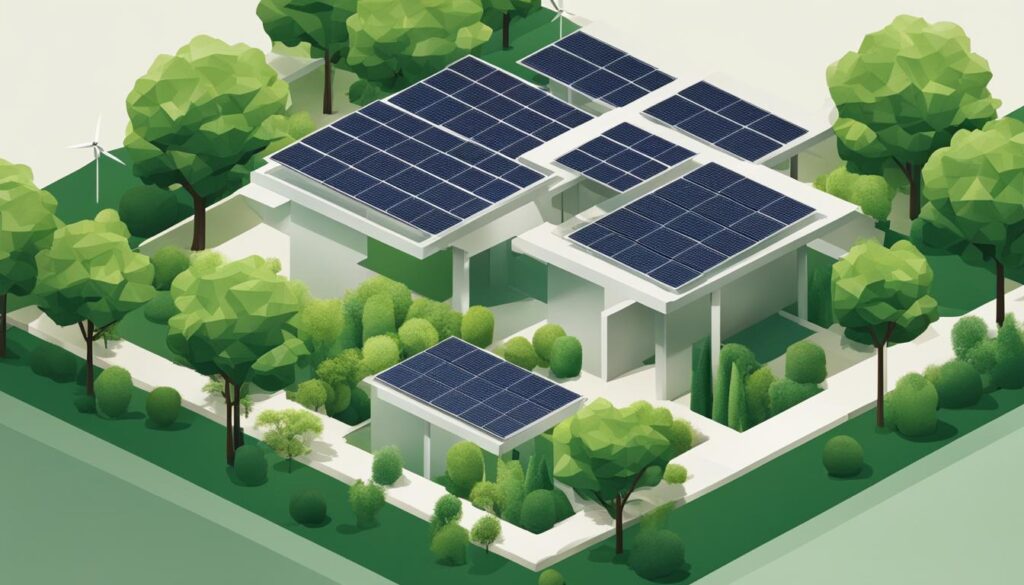
Benefits of FirstRate and the NCC:
- Improved energy efficiency: Buildings that comply with the NCC standards are designed to minimize energy consumption, resulting in lower electricity bills for occupants.
- Environmental sustainability: By meeting the NCC requirements, we contribute to reducing greenhouse gas emissions and mitigating climate change.
- Enhanced comfort: Buildings that meet the NCC standards provide better thermal comfort, ensuring a pleasant living or working environment.
- Cost savings: Energy-efficient buildings require less energy to operate, resulting in significant savings on heating, cooling, and lighting costs.
When it comes to sustainable building design, FirstRate and the NCC are the dynamic duo we need. They ensure that our buildings not only comply with energy efficiency standards but also provide comfortable and cost-effective spaces for generations to come. So, let’s embrace the power of FirstRate and the NCC and build a brighter, greener future.
Green Star Certification for Sustainable Architecture
When it comes to sustainable architecture, the Green Star certification offered by the Green Building Council Australia is the gold standard. This certification program recognizes and rewards buildings that prioritize environmental sustainability in their design and construction. Achieving a Green Star rating signifies a commitment to creating a greener and more sustainable built environment.
“Green Star certification is not just about putting a tick on a building; it’s about transforming the way we think about architecture and urban planning. It challenges us to incorporate sustainable design principles into every aspect of the building process, from energy efficiency to materials selection.”
Green Star ratings range from 4 Stars to 6 Stars, with 6 Stars being the highest attainable rating. Buildings that achieve a Green Star rating are leaders in sustainable design and construction, setting an example for the industry and demonstrating the positive impact that environmentally conscious buildings can have on our planet.
Innovative Design Strategies for Green Star Certification
To achieve Green Star certification, buildings must meet rigorous criteria across a range of categories, including energy efficiency, water conservation, indoor environmental quality, and materials selection. Design strategies that can contribute to a higher Green Star rating include:
- Passive design principles, such as maximizing natural light and ventilation
- Efficient use of water through rainwater harvesting and greywater recycling
- Integration of renewable energy sources, such as solar panels
- Use of sustainable materials with low embodied carbon
- Implementation of waste management and recycling programs
| Green Star Rating | Description |
|---|---|
| 4 Stars | Best practice |
| 5 Stars | Australian excellence |
| 6 Stars | World leadership |
By embracing sustainable design principles and pursuing Green Star certification, architects and developers have the opportunity to create buildings that not only reduce their environmental footprint but also provide healthier and more comfortable spaces for occupants. Green Star buildings are a testament to the power of design to shape a better future for our planet and our communities.
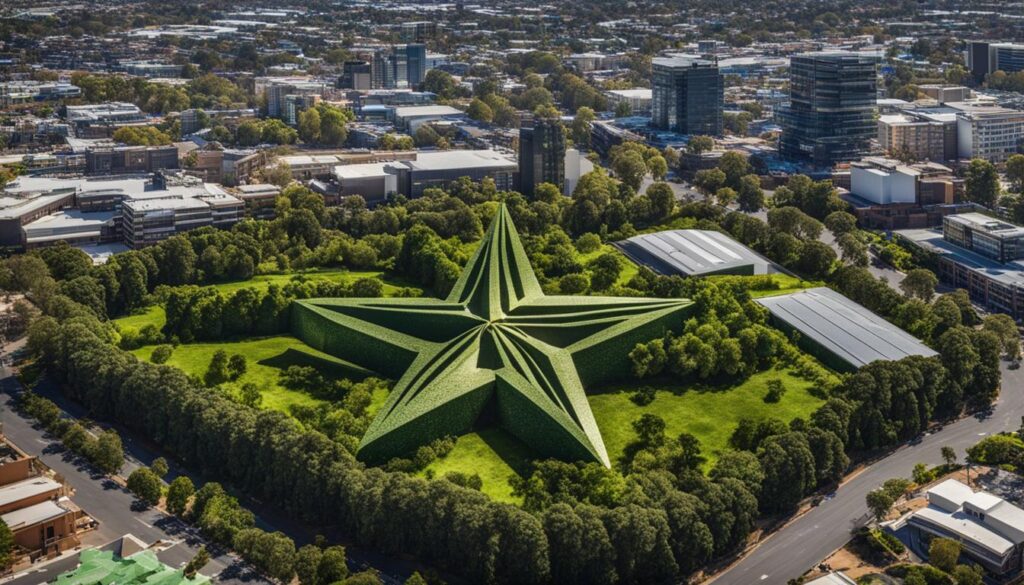
Sustainable Subdivision Framework
The City of Greater Bendigo is committed to sustainable development and is actively working towards implementing environmentally friendly practices in the region. As part of this effort, the council is collaborating with the Council Alliance for a Sustainable Built Environment and other local governments to develop a Sustainable Subdivision Framework.
This framework aims to assess the environmental performance of subdivisions as part of the planning application process, complementing the existing sustainable design assessment process for buildings. By incorporating sustainable development solutions from the early stages of planning, the council aims to create more eco-friendly and efficient subdivisions that align with their environmental objectives.
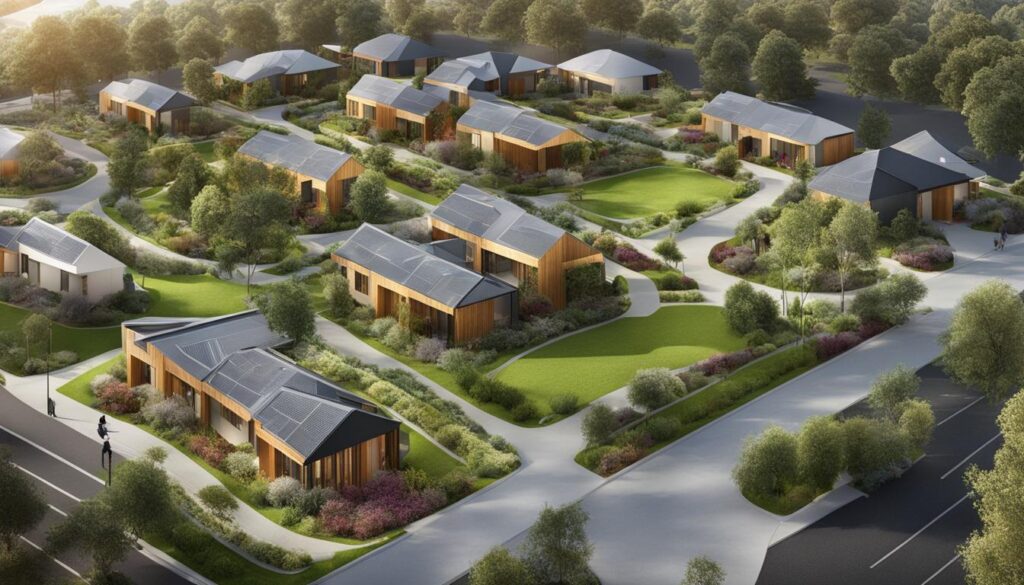
Benefits of the Sustainable Subdivision Framework
The Sustainable Subdivision Framework will bring numerous benefits to the Greater Bendigo region. Firstly, it will help improve the overall sustainability of new subdivisions by reducing their environmental impact. By implementing eco-friendly practices from the outset, the council can create developments that are more energy-efficient and have a lower carbon footprint.
Secondly, the framework will contribute to the council’s efforts to create a more livable and inclusive community. Sustainable subdivisions can incorporate features such as green spaces, accessible infrastructure, and public amenities, enhancing the overall quality of life for residents.
Finally, the Sustainable Subdivision Framework will also promote cost-effective development. By integrating sustainable design principles and energy-efficient infrastructure, the council can help reduce long-term operating costs for subdivisions while also providing residents with more affordable and sustainable housing options.
Benefits of Environmentally Sustainable Design in Subdivisions
When it comes to regional subdivisions, embracing environmentally sustainable design (ESD) brings about a multitude of benefits. Not only does it contribute to the overall well-being of the environment, but it also creates social and economic advantages for communities. By prioritizing sustainable development practices, we can foster a greener and more resilient future.
One of the key benefits of ESD in regional subdivisions is the reduction of environmental impact. By incorporating green building techniques, such as energy-efficient design, water conservation measures, and the use of sustainable materials, we can significantly decrease our carbon footprint. This not only helps mitigate climate change but also protects the natural resources and ecosystems that are essential for a healthy environment.
Furthermore, ESD can improve the quality of life for residents in regional subdivisions. By creating green spaces, promoting active transportation options, and designing walkable neighborhoods, we can enhance community well-being and encourage a healthier lifestyle. Additionally, sustainable development practices can help lower utility costs for homeowners, making housing more affordable in the long run.
| Benefits of ESD in Subdivisions | Summary |
|---|---|
| Reduction of environmental impact | Contributes to mitigating climate change and protecting natural resources |
| Improved quality of life | Enhances community well-being and promotes a healthier lifestyle |
| Lower utility costs | Makes housing more affordable in the long run |
Implementing environmentally sustainable design in regional subdivisions not only benefits the planet but also creates vibrant and livable communities. By adopting sustainable development practices, we can create a future that is environmentally conscious, socially inclusive, and economically viable.
It is important for policymakers, developers, and residents to recognize the value of ESD in regional subdivisions. By embracing sustainable design principles and integrating them into the planning and development processes, we can create a harmonious balance between human needs and the environment. Through collaboration and commitment to sustainable development, we can pave the way for a brighter and greener future.
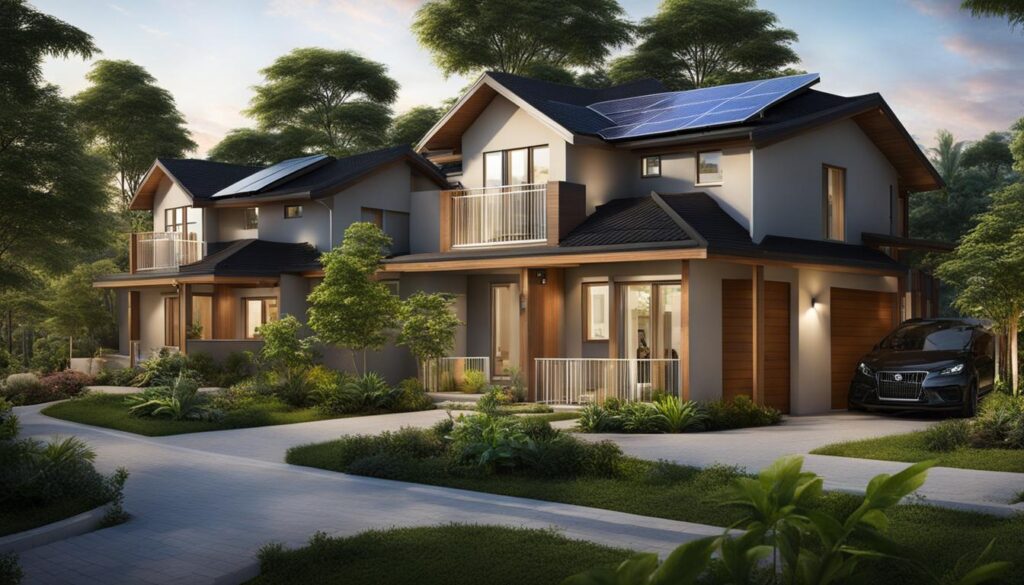
Delivering Environmentally Sustainable Design (ESD) Services to Local Governments
As an advocate for environmentally sustainable design (ESD), I am excited to share how the Council Alliance for a Sustainable Built Environment and the Central Victorian Greenhouse Alliance are working together to deliver ESD services to local governments. This collaborative effort aims to improve the cost-effectiveness and efficiency of implementing ESD principles individually or in collaboration with other councils.
The Council Alliance for a Sustainable Built Environment and the Central Victorian Greenhouse Alliance recognize the importance of integrating sustainable practices into local government planning and development processes. By providing ESD services, they aim to support councils in their pursuit of sustainable urban planning and development strategies. These services assist in identifying opportunities for enhancing energy efficiency, reducing greenhouse gas emissions, and promoting sustainable building practices at the local level.
Supporting Integration of ESD Expertise
A service delivery plan is currently being developed to support the integration of ESD expertise into local government operations. This plan aims to streamline the delivery of ESD services and ensure consistent and effective implementation of sustainable design practices across different councils. By pooling resources and sharing knowledge, the Council Alliance for a Sustainable Built Environment and the Central Victorian Greenhouse Alliance will enable local governments to access specialized ESD support and guidance.
I am thrilled to see the commitment of these alliances to deliver ESD services to local governments. This collaborative approach will not only promote sustainable urban planning but also enhance the livability and environmental performance of our cities and communities. By working together, we can create a more resilient and eco-friendly built environment that benefits both current and future generations.
Challenges and Opportunities for ESD in Regional Victoria
In regional Victoria, implementing Environmentally Sustainable Design (ESD) principles in subdivisions presents both challenges and opportunities. While there is growing recognition of the importance of sustainable development, there are gaps in the planning provisions and policy objectives that need to be addressed. The report on Environmentally Sustainable Design for Subdivisions in Regional Victoria highlights the need to strengthen statewide ESD approaches and commitment to achieve better outcomes.
One of the challenges is the lack of clear and consistent planning requirements for ESD in subdivisions. The current planning provisions often focus on individual buildings rather than considering the broader environmental impact of the entire subdivision. Addressing this challenge involves enhancing the Infrastructure Design Manual, which provides guidance on sustainable design practices, and integrating ESD principles into the planning and building regulations.
However, the challenges also open up opportunities for improving sustainability in subdivisions. By implementing stronger policy objectives and planning provisions, regional Victoria can create a framework that encourages developers and homeowners to prioritize sustainable practices. This can lead to significant environmental benefits, such as reduced energy consumption, improved water management, and enhanced biodiversity.
Furthermore, non-statutory measures, such as education, information, tools, and incentives, can play a crucial role in promoting better ESD outcomes. By providing access to resources and knowledge, stakeholders can make informed decisions and implement sustainable design principles effectively. This can create a ripple effect, inspiring others to follow suit and contribute to a more sustainable future for regional Victoria.
Table: Challenges and Opportunities for ESD in Regional Victoria
| Challenges | Opportunities |
|---|---|
| Lack of clear planning requirements for ESD in subdivisions | Enhancing statewide ESD approaches |
| Focus on individual buildings rather than the entire subdivision | Integrating ESD principles into planning and building regulations |
| Improving the Infrastructure Design Manual | |
| Promoting education, information, tools, and incentives |
Conclusion
Alrighty then, it’s time to wrap things up and put a bow on this exploration of Environmentally Sustainable Design (ESD) in the Greater Bendigo City Council. We’ve delved into the policies, tools, and collaborations that are shaping a greener future for this region. And let me tell you, it’s a sight to behold!
The Greater Bendigo City Council isn’t just paying lip service to sustainable urban planning; they’re walking the talk. With their Environmentally Sustainable Design Policy leading the way, they’ve made it mandatory for certain developments to submit a Sustainable Design Assessment as part of the planning permit process. Talk about commitment!
We can’t forget to mention the nifty Built Environment Sustainability Scorecard (BESS) that helps evaluate the sustainability of medium to large scale buildings. It’s the secret sauce that streamlines the planning permit process and uncovers opportunities to lower running costs. Kudos to the City of Greater Bendigo for embracing this tool!
But wait, there’s more! The Greater Bendigo City Council is also teaming up with other local governments to develop a Sustainable Subdivision Framework. They’re not just focused on individual buildings; they’re looking at the bigger picture and assessing the environmental performance of subdivisions. Now that’s what I call thinking ahead!
So, my friends, let’s raise a glass to the Greater Bendigo City Council and their commitment to environmentally sustainable design. By integrating these practices into the planning and development processes, they’re paving the way for a more sustainable and eco-friendly built environment. It’s a win-win for everyone, and I can’t wait to see what they’ll achieve next!
FAQ
What is Environmentally Sustainable Design (ESD)?
Environmentally Sustainable Design (ESD) refers to the practice of integrating sustainable principles into the planning, design, construction, and operation of buildings and subdivisions to minimize environmental impact and promote resource efficiency.
What is the Environmentally Sustainable Design Policy in Greater Bendigo?
The Environmentally Sustainable Design Policy in Greater Bendigo City Council’s Planning Scheme mandates the submission of a Sustainable Design Assessment for certain residential and non-residential developments. It aims to encourage sustainable building practices and reduce the environmental impact of new constructions.
What is the Built Environment Sustainability Scorecard (BESS)?
The Built Environment Sustainability Scorecard (BESS) is an online assessment tool that helps evaluate the sustainability of medium to large scale buildings. It sets best practice benchmarks in various environmental categories and can be used to assess any size and type of building, including mixed-use developments.
What is FirstRate and its connection to the National Construction Code?
FirstRate is a commonly used software to demonstrate compliance with the National Construction Code of Australia, which sets minimum standards to achieve energy efficiency objectives and ensure the health, safety, and amenity of buildings. FirstRate uses the NatHERS protocol to assess the energy efficiency of buildings.
What is Green Star Certification for large scale buildings?
To demonstrate best practice sustainability, large scale buildings can obtain Green Star certification from the Green Building Council Australia. Green Star ratings range from 4 to 6 Stars and indicate a high level of sustainable design and construction, contributing to eco-friendly urban planning and architecture.
What is the Sustainable Subdivision Framework?
The Sustainable Subdivision Framework is being developed by the City of Greater Bendigo in collaboration with the Council Alliance for a Sustainable Built Environment and other local governments. It aims to assess the environmental performance of subdivisions as part of the planning application process, complementing the existing sustainable design assessment process for buildings.
What are the benefits of Environmentally Sustainable Design in subdivisions?
Environmentally Sustainable Design in regional subdivisions brings several social, economic, and environmental benefits. It improves the cost-effectiveness of greenfield developments while reducing their environmental impact, contributing to a sustainable and eco-friendly built environment.
How are Environmentally Sustainable Design (ESD) services delivered to local governments?
The Council Alliance for a Sustainable Built Environment and the Central Victorian Greenhouse Alliance support the delivery of ESD services into local governments. This collaborative effort aims to improve the cost-effectiveness and efficiency of implementing ESD principles individually or in collaboration with other councils.
What are the challenges and opportunities for ESD in regional Victoria?
The report on Environmentally Sustainable Design for Subdivisions in Regional Victoria identifies gaps in the planning provisions and requirements for ESD principles in current planning and building regulations. It recommends strengthening statewide ESD approaches, enhancing the Infrastructure Design Manual, and implementing non-statutory measures to promote better ESD outcomes.
How is the City of Greater Bendigo promoting Environmentally Sustainable Design?
The City of Greater Bendigo is taking significant steps towards promoting Environmentally Sustainable Design in the region. Through policies, tools like the Built Environment Sustainability Scorecard, and collaborations with other councils, Greater Bendigo aims to shape a greener future by integrating sustainable design practices into the planning and development processes.
Source Links
- https://www.casbe.org.au/news/delivering-environmental-sustainable-design-esd-services-into-loddon-campaspe-local-governments/
- https://www.bendigo.vic.gov.au/community-services/environment/sustainable-design
- https://www.clearwatervic.com.au/resource-library/case-studies/environmentally-sustainable-design-for-subdivisions-in-regional-victoria.php
